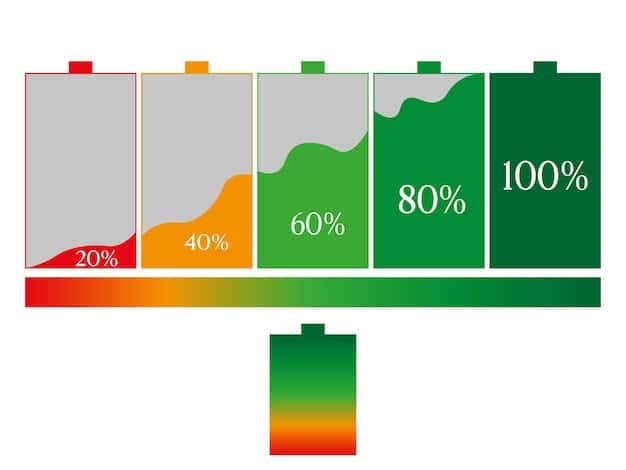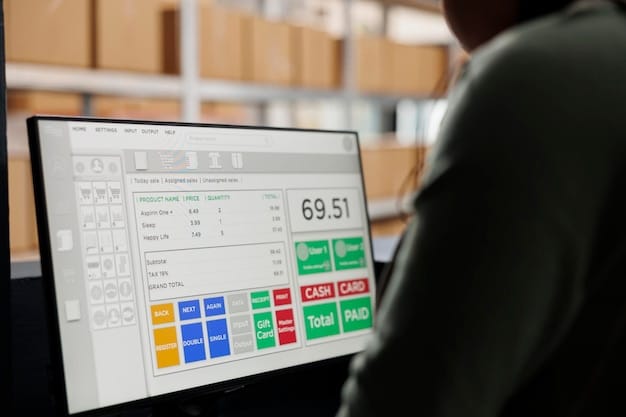E-commerce Inventory: Reduce Waste by 10% in US Platforms

E-commerce platform inventory management is essential for optimizing US stock levels, reducing waste by 10% through efficient tracking, demand forecasting, and streamlined logistics, leading to cost savings and improved customer satisfaction.
Effectively managing inventory on e-commerce platforms is crucial for US-based businesses aiming to minimize waste and maximize profitability. By implementing strategic inventory practices, e-commerce businesses can optimize stock levels and reduce waste by up to 10%, resulting in cost savings and improved customer satisfaction. E-commerce platform inventory management: Optimizing your US stock levels to reduce waste by 10% is not just about avoiding stockouts; it’s about creating a lean, efficient supply chain that aligns with customer demand and minimizes environmental impact.
Why E-commerce Inventory Management Matters for US Businesses
Effective inventory management is the backbone of any successful e-commerce business in the US. It directly impacts profitability, customer satisfaction, and operational efficiency. Poor inventory practices can lead to stockouts, overstocking, and ultimately, wasted resources.
For US e-commerce businesses, efficient inventory control is not a luxury; it’s a necessity. Let’s explore the key reasons why it matters.
Reducing Costs and Maximizing Profits
Efficient inventory management helps reduce carrying costs, such as storage fees, insurance, and obsolescence. By optimizing stock levels, businesses can avoid tying up capital in excess inventory and free up resources for other strategic investments.
Enhancing Customer Satisfaction
Accurate inventory tracking ensures that products are available when customers want them. This leads to improved order fulfillment rates and fewer instances of stockouts, resulting in happier customers and increased loyalty.
- Improved Order Accuracy: Minimizing errors in order fulfillment.
- Faster Shipping Times: Expediting the delivery process.
- Real-time Visibility: Providing customers with accurate inventory information.
Without proper inventory control, businesses risk disappointing customers, which can lead to negative reviews and lost sales.
Effective inventory management is not just about counting products; it’s about understanding market trends, forecasting demand, and making informed decisions about what to stock, when to stock it, and how much to stock. This leads to better financial outcomes and a stronger competitive position in the US market.

Key Strategies for Optimizing US Stock Levels
Optimizing stock levels is crucial for minimizing waste and maximizing profitability in e-commerce. Several strategies can help US businesses achieve this goal. These strategies involve leveraging technology, analyzing data, and implementing best practices.
Here are some key strategies to consider:
Demand Forecasting and Analysis
Accurate demand forecasting is essential for predicting future sales and ensuring the right amount of inventory is available. By analyzing historical sales data, market trends, and seasonal patterns, businesses can anticipate demand fluctuations and adjust stock levels accordingly.
Implementing an ABC Analysis
ABC analysis categorizes inventory items based on their value and importance. “A” items are high-value products that require close monitoring, “B” items are moderate-value products, and “C” items are low-value products. This allows businesses to prioritize their inventory management efforts.
Leveraging Technology and Automation
Using inventory management software and automation tools can streamline processes, improve accuracy, and reduce human error. These tools provide real-time visibility into inventory levels, track product movement, and automate replenishment orders.
- Inventory Management Software: Centralizes data and automates tasks.
- Barcode Scanners: Improve accuracy in stock tracking.
- Automated Replenishment Systems: Ensure timely restocking based on demand.
These strategies enable businesses to make data-driven decisions about inventory levels, minimize waste, and improve overall efficiency. By adopting these practices, e-commerce businesses can achieve significant cost savings and improve customer satisfaction.
Optimizing stock levels requires a continuous effort to monitor performance, identify areas for improvement, and adapt strategies to changing market conditions. This ongoing process ensures that inventory management practices remain effective and aligned with business goals.
Choosing the Right E-commerce Platform for Inventory Management
Selecting the right e-commerce platform is critical for effective inventory management. Not all platforms offer the same level of functionality and integration. Choosing a platform that aligns with your business needs can significantly impact your ability to optimize stock levels and reduce waste.
Here are some factors to consider when choosing an e-commerce platform:
Inventory Management Features
Look for platforms that offer robust inventory management features, such as real-time tracking, automated reordering, and integration with accounting software. These features streamline processes and improve accuracy.
Integration Capabilities
Ensure that the platform can integrate with other business systems, such as CRM, ERP, and shipping providers. Seamless integration simplifies data sharing and improves overall efficiency.
Scalability and Flexibility
Choose a platform that can scale with your business and adapt to changing needs. A flexible platform allows you to add new features, customize workflows, and integrate with third-party apps.
Consider these platforms to elevate you E-commerce Platform Inventory Management:
- Shopify: Known for its user-friendly interface and extensive app ecosystem.
- Magento: Offers advanced customization options and scalability for larger businesses.
- WooCommerce: A flexible and cost-effective option for WordPress users.
Selecting the right e-commerce platform is a strategic decision that can significantly impact your ability to optimize inventory management and achieve your business goals. By carefully evaluating your needs and choosing a platform that aligns with those needs, you can improve efficiency, reduce costs, and enhance customer satisfaction. This also allows for more efficiency in e-commerce platform inventory management: Optimizing your US stock levels to reduce waste by 10%.

Practical Tips to Reduce Waste by 10% in US E-commerce
Reducing waste in e-commerce operations is not only environmentally responsible but also financially beneficial. By implementing practical tips, US businesses can reduce waste by 10% and improve their bottom line.
Here are some actionable tips to consider:
Optimize Packaging
Use sustainable packaging materials and minimize packaging size to reduce waste and shipping costs. Consider using recycled materials and avoiding excessive packaging.
Consolidate Shipments
Combine multiple orders into a single shipment whenever possible to reduce packaging materials and shipping costs. Offer customers incentives to consolidate their orders.
Manage Returns Effectively
Implement a clear and efficient return policy to minimize the number of returned items. Offer customers options such as exchanges, store credit, or refunds to encourage them to keep the product.
Other tips to maximize the practicality:
- Accurate Product Descriptions: Provide detailed product information to minimize returns due to misunderstandings.
- Quality Control: Implement quality control measures to ensure that products are in good condition before shipping.
- Inventory Aging Analysis: Monitor inventory aging and take action to sell or dispose of slow-moving items.
By implementing these practices, e-commerce businesses can minimize waste, reduce costs, and improve their environmental footprint. Small changes can add up to significant savings and a more sustainable business.
Reducing waste requires a holistic approach that involves all aspects of the business, from sourcing materials to shipping products. By integrating sustainability into your business strategy, you can create a more efficient, profitable, and environmentally responsible operation.
Measuring and Tracking Inventory Management Success
Measuring and tracking inventory management success is crucial for identifying areas for improvement and ensuring that strategies are effective. By monitoring key performance indicators (KPIs), businesses can gain insights into their inventory practices and make data-driven decisions.
Here are some essential KPIs to track:
Inventory Turnover Rate
Measures how quickly inventory is sold and replaced over a given period. A high turnover rate indicates efficient inventory management, while a low rate may suggest overstocking or slow-moving items.
Inventory Turnover Rate Formula: Cost of Goods Sold / Average Inventory Value
Stockout Rate
Indicates the percentage of items that are out of stock when customers want to purchase them. A high stockout rate can lead to lost sales and dissatisfied customers.
Stockout Rate Formula: (Number of Stockout Occurrences / Total Number of Order Attempts) * 100
Carrying Costs
Include all expenses associated with holding inventory, such as storage fees, insurance, and obsolescence. Minimizing carrying costs is essential for improving profitability.
Carrying Costs Formula: (Storage Costs + Insurance Costs + Obsolescence Costs + Opportunity Costs) / Total Inventory Value
The most popular ways to measure is:
- Inventory Accuracy: The accuracy of inventory records compared to physical counts.
- Order Fulfillment Rate: The percentage of orders that are fulfilled completely and on time.
- Waste Reduction: The percentage decrease in waste due to improved inventory management practices.
By tracking these KPIs, businesses can identify areas for improvement and measure the impact of their inventory management strategies. Regular monitoring and analysis ensure that inventory practices are effective and aligned with business goals.
Measuring inventory management success requires a commitment to data collection, analysis, and continuous improvement. By using data to inform decisions and track progress, businesses can optimize their inventory practices and achieve significant cost savings.
Future Trends in E-commerce Inventory Management in the US
The field of e-commerce inventory management is constantly evolving, with new technologies and strategies emerging to address the challenges of a dynamic market. Staying informed about future trends is essential for US businesses looking to maintain a competitive edge. Especially for optimizing e-commerce platform inventory management: Optimizing your US stock levels to reduce waste by 10%.
Here are some key trends to watch:
Artificial Intelligence (AI) and Machine Learning
AI and machine learning are transforming inventory management by enabling more accurate demand forecasting, automated decision-making, and personalized customer experiences. These technologies can analyze vast amounts of data to identify patterns and predict future trends.
Blockchain Technology
Blockchain technology is improving transparency and traceability in the supply chain, allowing businesses to track products from origin to delivery. This can help reduce fraud, improve product authenticity, and streamline inventory management.
Sustainable Inventory Practices
As consumers become more environmentally conscious, businesses are adopting sustainable inventory practices to reduce waste and minimize their environmental impact. This includes using eco-friendly packaging, optimizing shipping routes, and implementing circular economy models.
For maximizing Inventory and Waste Management:
- Real-Time Inventory Visibility: Provides accurate information about stock levels across all channels.
- Predictive Analytics: Uses data to forecast future demand and optimize inventory levels.
- Automated Replenishment: Automatically reorders products based on demand and inventory levels.
By embracing these trends, e-commerce businesses can improve efficiency, reduce costs, and enhance customer satisfaction. Staying ahead of the curve is essential for maintaining a competitive advantage in the ever-evolving e-commerce landscape.
Keeping tabs on these future trends will streamline the whole process of inventory.
| Key Point | Brief Description |
|---|---|
| 📦 Inventory Optimization | Strategies to reduce waste and maximize profits. |
| 📊 Demand Forecasting | Predicting sales to ensure optimal stock levels. |
| 🌱 Sustainable Practices | Eco-friendly packaging and waste reduction initiatives. |
| 🤖 Automation | Using software to streamline inventory processes. |
Frequently Asked Questions
▼
Inventory management helps e-commerce businesses optimize stock levels, reduce waste, improve customer satisfaction, and maximize profitability. Without proper inventory control, businesses risk stockouts or overstocking issues.
▼
Key strategies include demand forecasting, ABC analysis, leveraging technology, implementing safety stock levels, and optimizing packaging. These strategies helps make more informed decisions about what to stock.
▼
E-commerce platforms can reduce waste by optimizing packaging, consolidating shipments, managing returns effectively, and using sustainable materials. These practices helps create a more efficient, profitable business.
▼
Common KPIs include inventory turnover rate, stockout rate, carrying cost, order fulfillment rate, and waste reduction. By tracking these KPIs, businesses can measure impact on business goals.
▼
E-commerce businesses should watch for trends such as AI, blockchain technology, sustainable inventory practices, and real-time visibility. Integrating these tech trends imporves efficiency of busineses.
Conclusion
Effective e-commerce platform inventory management is crucial for US businesses aiming to optimize stock levels and reduce waste. By implementing strategic inventory practices, choosing the right e-commerce platform, and staying informed about future trends, businesses can achieve significant cost savings and improve customer satisfaction.





